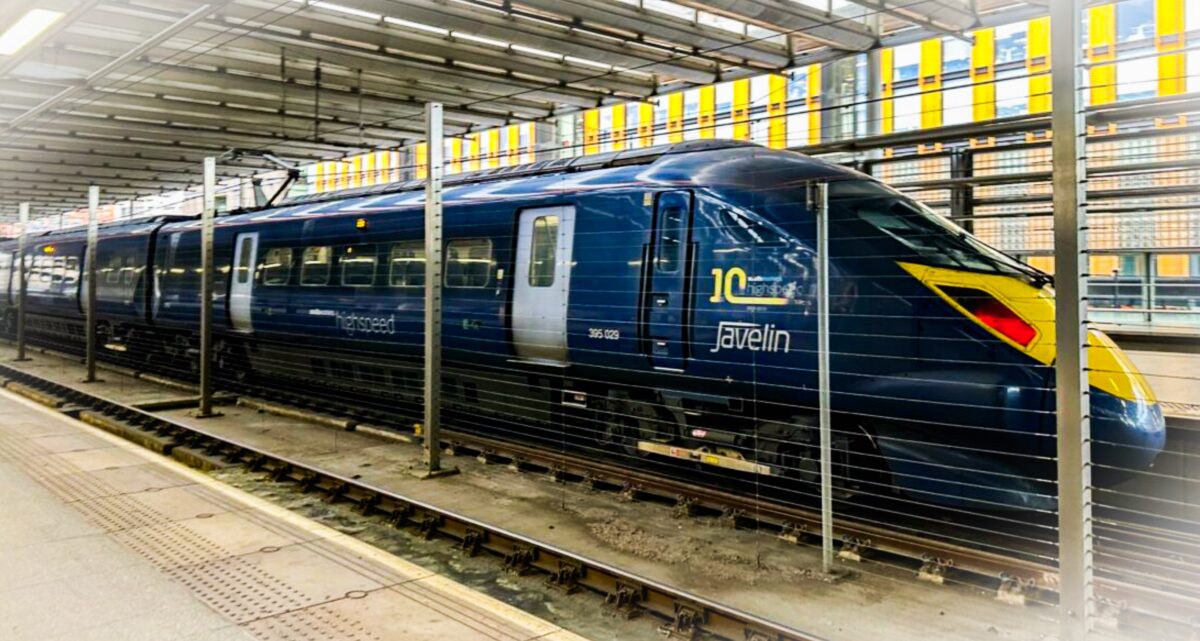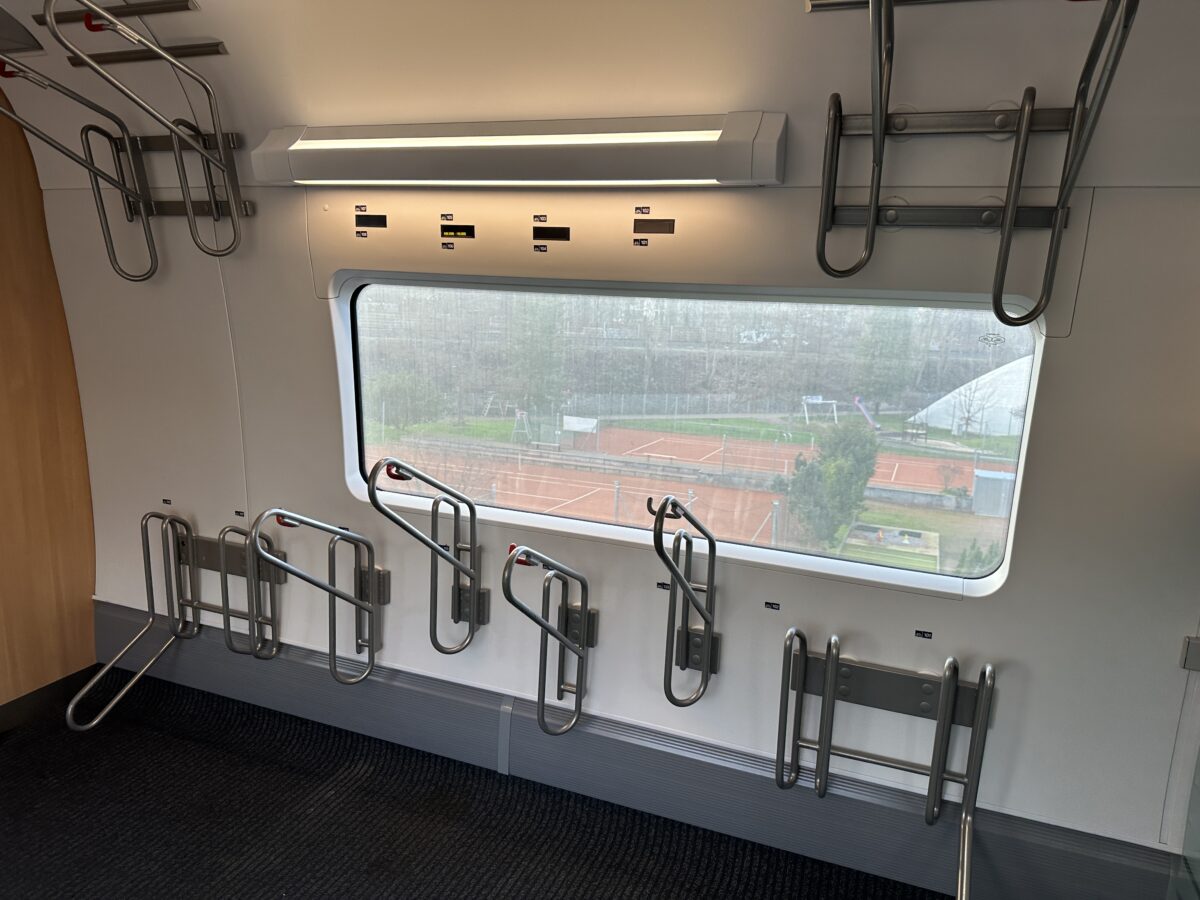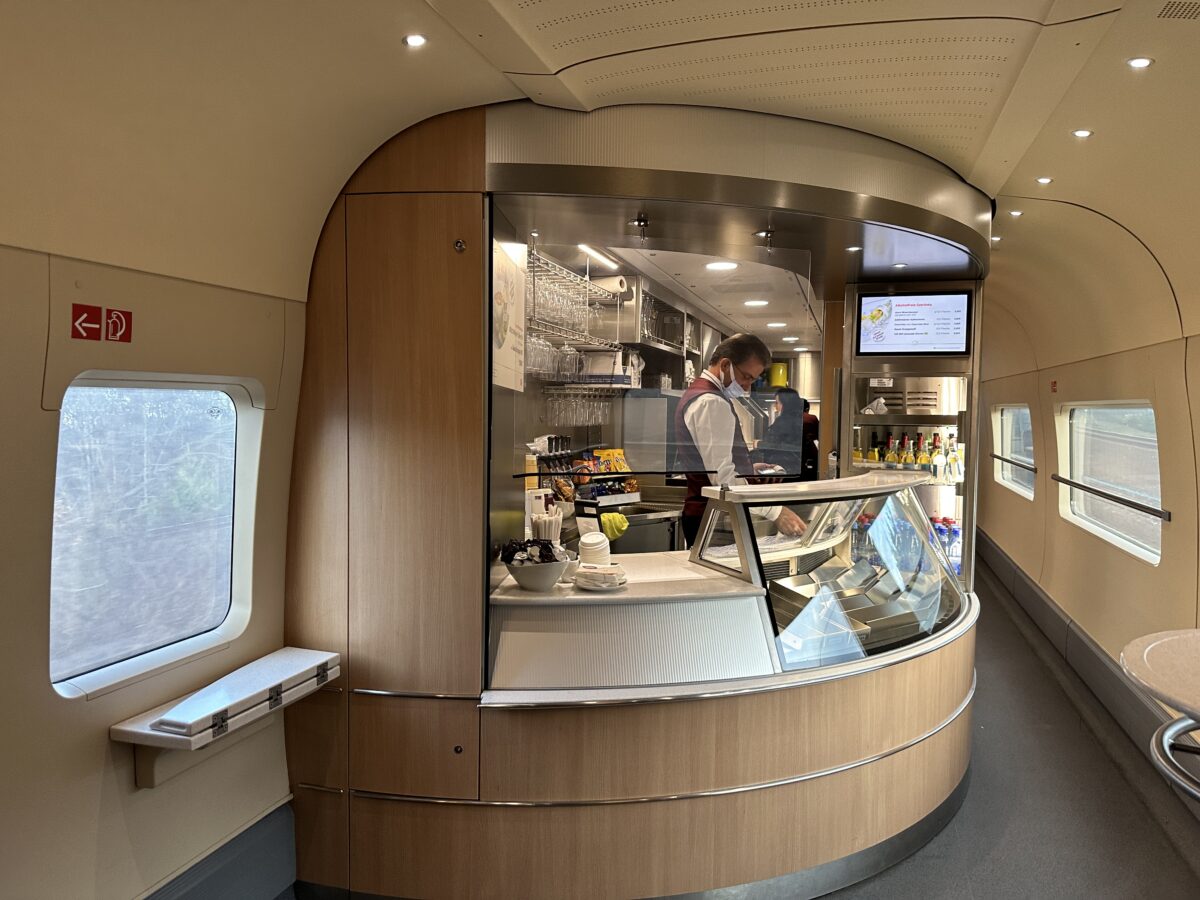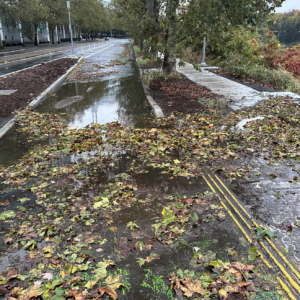
— This post is part of BikePortland Staff Writer Taylor Griggs’ trip through Europe. See previous dispatches here.
Don’t get me wrong, I’ve been very impressed with the bike infrastructure in the European cities I’ve visited so far. But throughout my travels over the last couple of weeks, I’ve realized that separated bike lanes and carfree streets — while lovely and quite enviable — aren’t actually the element of European transportation that could convince me to try to permanently emigrate abroad. The rail system, on the other hand? That’s a different story.
I’ve expressed my enthusiasm for Amtrak on BikePortland before, and I’ll do it again: I’m charmed by American rail travel. I like its quirks and the sense of community it fosters, and I’ve seen some of the most memorable, awe-inspiring natural scenery of my life from the Amtrak observation car. But after seeing what dignified train travel looks like, I have to say that some of that affection has diminished…or at least evolved a bit.


It’s not entirely fair to compare intercity train travel in Europe and the United States because the European countries have a clear geographical advantage: their cities are actually close together. The entire continent of Europe, including western Russia, is just slightly bigger than the lower 48 states in the U.S., and many of the major capitals — London, Paris, Brussels, Amsterdam, Berlin, Vienna — are located fairly close together, at least by American standards.
But it’s not just about city proximity. Even if we can’t pick up and move the major American cities closer together, there’s still a lot we can do. In Europe, trains actually come on time, are scheduled multiple times a day and are fast. Many European countries have invested in high-speed rail. The trains stop in small towns, not just big cities, making it possible for people living in the countryside to travel without a car. Taking the train is the fastest and most efficient option for getting from one city to another a lot of the time, and countries like France are making it mandatory to go by rail instead of flying in an effort to combat carbon emissions.
Earlier this week, I traveled from Copenhagen to Paris, which took about 13 hours on the train altogether (I made a stop in Hamburg to split up the trip). These cities are about the same distance apart as Portland and San Francisco, but a nonstop Amtrak trip to the Bay Area from Portland takes about 19 hours — much longer than it would take to drive.
Imagine if we had high-speed rail! Following in the footsteps of my colleague Lisa Caballero, I rode France’s TGV high-speed rail earlier this week and was similarly struck by how far behind we are in the U.S. It is exciting to see the advances in discussions for ultra-high speed rail in the Pacific Northwest and I am also glad Amtrak is lowering fares for travelers on the Cascades route. But it’s depressing to think about how long it will take these projects to come to fruition, if they do at all.
And then there are the delays. U.S. passenger rail is dictated by the freight industry (which has a surprisingly large grip on the entire American transportation sector, including locally). Amtrak and Union Pacific — the rail company that hauls freight all over the American west — have to share the rails, which means that they’re constantly battling for access to the tracks.
Even though passenger rail is supposed to have preferential right-of-way over freight, Amtrak trains are constantly held up by Union Pacific, sometimes for hours on end. (A passenger train was just stuck in rural South Carolina with limited food supplies for more than 20 hours last week.) After seeing how people in Europe react when their train is a few minutes late (which has really not been common — usually they are exactly on time), it’s seems all the more ridiculous to me that we put up with this kind of thing in the U.S.
Of course, this past holiday season’s airline meltdown showed that all modes of transportation are subject to failure at times. But the federal government has never paid as much attention to passenger rail as they have to subsiding airlines, and it’s extremely obvious.
I love traveling, but I also feel it’s my responsibility to limit my personal carbon emissions as much as possible. Our planet cannot sustain the amount of air travel Americans are doing, but with the system that we have it’s also unrealistic to expect much else.
I will keep riding Amtrak for the views, the charming experience and to avoid flying. But based on past experiences, like one egregious situation in which I was stuck on a train in the desert for 15+ hours, missed my connecting train and had to shell out $200 for a last-minute one-way flight, I know I can’t do it if I have anywhere I need to be in a timely manner. So I will continue to be one of a few Americans who takes the train. And although I’m fine going it alone from time to time, I’d really prefer others were able to join me on this one.







Thanks for reading.
BikePortland has served this community with independent community journalism since 2005. We rely on subscriptions from readers like you to survive. Your financial support is vital in keeping this valuable resource alive and well.
Please subscribe today to strengthen and expand our work.
One of the flip sides of those truly excellent passenger trains in Europe is that way too much frieight is moved by truck there compared to the USA. Europe has freight trains, but at a much smaller scale than in the USA, both in the percentage of freight carried and of the trains themselves, some of which is made up by better inland waterway and canal barge traffic. The equally extensive highway systems in Europe are packed with huge semi traffic.
But yeah, I too love the passenger trains in Europe, particularly the Mittle Rhine and Alpine routes, Railjet in Austria, the Great Eastern in the UK, and the modern TER trains that go village to village in France.
I took a train in Switzerland where you could literally ski from the doors of the train.
From what I can find on the internets, it’s 72% in the US and 77% in Europe. Not really a huge difference. What you do see in the US, however, is a lot of bulk freight moved by train, whereas much of this “low value” freight is moved by boat in Europe.
Our “pro-labor” president was the only reason freight railroads in the US didn’t come to a crippling halt late last year, and it should be a wake up call. No one should be using the US freight rail system as a model:
https://www.nytimes.com/2022/10/09/opinion/business-economics/freight-train-mismanagement.html
Hey I rode Amtrak from Portland to the Bay Area last weekend (in coach!), and loved it. I took the train in part because it was the choice that gave me the most time (I was just there for the 3 day weekend). Leaving Portland at 2:20 on Friday, I got into Martinez at 8:00 am the next day – if I had driven I would’ve gotten in well after midnight and gone straight to bed – so no real difference there. On the way back, I left at 10:30 PM on Monday, and got back in Portland at 3:15 or so – since I could work from the train this wasn’t a big issue. If I had driven, I would’ve had to leave the bay earlier on Monday to get home before Tuesday morning. I had to sleep in coach, but that’s not so bad in my book.
But to improve service, I think there are some real tangible things we should focus on.
I’d throw nationalization in there too – but I think that would be a bit of a longer lift politically speaking. Also have to throw in that BNSF and Union Pacific have a duopoly over western freight rail shipping – although both Canadian National and Canadian Pacific also compete in the long haul market between the larger PNW region (including Vancouver) and the Midwest/South.
I think the (very old) Superliner passenger cars on Amtrak’s long-distance trains have a supposed, allowed top speed of 100 mph unlike the other ones that Siemes and Talgo can build to go 125 mph (being pulled by a locomotive). More double and triple tracks would be nice along with improving pinch-points.
Except that we don’t have a single section of track on the west coast that would permit speeds above 79mph, and there are no plans to build any (outside of the struggling California HSR project that won’t deliver for 10+ years).
Given the curvy route to Seattle, we would see more time savings from level-platform boarding, and e-ticketing changes. Make it so people can wait on the platforms, have the train pull up, and board. That will shave 5-10 minutes off of every stop and save more time between Portland and Seattle than a few stretches of 90 or 110mph track.
Boarding is easy, but it’s people getting off that is so slow. In Europe you yourself open the doors with the green button. In the USA, only authorized personnel are allowed to open doors. Seat reservations like they do on airplanes would also make it more user-friendly, with seat maps.
Last time I rode the train in Europe you had to go reserve your seat after buying your ticket, if you wanted to sit down. You know, unless the train was empty.
Since the freight companies own the rails, and Amtrak borrows them, they’ll have to negotiate priority. However, I’m sure they could get it for a check with a suitable number of digits. Or they could build their own tracks, as is happening in California. That project should be done in time for the 2100 presidential election.
[Or they could just buy BNSF for $200B and prioritize things however they want.]
Some states, Montana, New Jersey, Virginia and North Carolina for example, own some of their own tracks outright through their DOTs. Here in NC, both the local NC and Amtrak trains have priority over freight on the NC-owned main line between Raleigh & Charlotte, which is rented and operated by #4 railroad Norfolk & Southern (black and white engines with horse symbols on them – we often see #3 UP engines out here too). NC passenger train engines are painted to look a bit like the state flag and each is named after an important city in the state – the passenger cars are all renovated 1970s cars with comfy leather seats and ADA facilities – bikes are free between NC cities – 3 daily in each direction. The state just bought the line from Asheville to Beaumont, from the mountains* to the coast, from #1 railroad CSX. There’s also 4 daily Amtrak long-distance trains that pass through the state. We have European double-decker passenger cars on order for the state rail lines.
Amtrak owns the electrified main line between Washington DC and Boston, plus several short lines, and rents them out to the freight companies.
Warren Buffet owns #2 BNSF. You can ask him nicely if he’ll sell.
*NC has the loftiest mountains in all of the East Coast, including Mt Mitchell, which at 6,800 ft is still laughable by West Coast standards.
I feel like I’ve said it a million times, but Amtrak does not “borrow” or “rent” rails from railroad companies – it was created to relieve them of a legal requirement of running passenger trains. Railroad companies have 50+ years of operating with impunity and no punishment – this it what needs to change.
“Amtrak does not “borrow” or “rent” rails from railroad companies”
What is the arrangement between Amtrak and the companies on the tracks?
Amtrak provides the railroad companies a service that they previously were legally required to provide. Amtrak does not pay for the right to use the rails.
(from https://www.amtrak.com/content/dam/projects/dotcom/english/public/documents/corporate/position-papers/white-paper-amtrak-and-frieght-railroads.pdf)
That does not look anything reminiscent of borrowing or renting to me.
Just doing these two would make a huge difference in the quality of Amtrak service. Unfortunately, they’d require the FRA to make the rail monopolies do 1 of two things that they are deathly allergic to. 1) Make capital investments in infrastructure to build longer sidings or 2) Not run monster trains.
Blumdrew (and others): Regarding the issue of Amtrak train (passengers) priority over freight trains…the key is how successful the state DOT/ Legislature is on being a consistent partner (paying priority fees & not threatening to stop funding passenger rail service).
Oregon was notorious for this problem during the last decade (the last time I researched it*)…versus how Washington State / DOT has invested in rail passenger service. Imagine if Oregon invested in more frequent trains to Eugene AND even extending the service further south. [AND it depends on the freight company too…BNSF is a pain to work with but UP is worse from what I have been told.]
*I am still waiting for Amtrak to restart passenger rail service in Hawaii. 😉
A working partnership is important of course, but I do think it’s kinda wack that we have to pay a “priority fee” for something that is (technically) legally mandated. It should be a no brainer for ODOT to run at least one or two more trains between Portland and Eugene – I can’t even scrape together a reasonable day trip with the current schedule. I get that they probably need more rolling stock, but that’s the sort of thing we should have dealt with 10 years ago! I guess it’ll be a long 3 years waiting for the new trainsets to come in.
I’d love for Cascades service to extend further south, especially if it went via the old Siskiyou line to Medford/Grants Pass/Ashland. Not sure what the track condition is like, or what the cost would be though – but that part of Oregon hasn’t had any train service since the late 40s, and hasn’t had much since Southern Pacific completed the line through Klamath Falls in the 1920’s.
I have looked into taking Amtrak from Orange County, California to Portland few times. I would have had to get off and transfer trains in Los Angeles. I would also have had to transfer to a bus to ride through a desert or two. There might have been more, I don’t remember. It was a long time ago.
We came back from Disneyland on Amtrak in the before times. We had rented a car in Anaheim, and the car rental agency dropped us off at the nearest Metrolink station. We took that to LA Union Station and the Coast Starlight from there. Pretty painless.
I am glad it was pretty painless for you. The car probably helped a lot
There are a few options coming up from LA, and you may have been looking at the Bus to San Joaquins to Coast Starlight option, which involves multiple transfers but is technically faster. Amtrak will also give you a single train option from LA to Portland on the Coast Starlight. We did this last March in a Roomette and it was a great trip (but not cheap).
Disneyland to Union Station is a bit more problematic. If you are staying near Disneyland, you can Uber or local bus to Metrolink. We’ve done the local bus option, and it works, but it takes a few hours once you add up all the transfer time. This is more of an issue with Orange County, and their lack of transit options in and around Disneyland. If you are looking to do a Coast Starlight/Disneyland trip in the future, I would recommend including Downtown LA as part of the trip. Downtown LA has a lot to offer, and so many people completely skip over it. If you spend even just one night downtown at the end of the trip, it makes it so much easier to catch the train.
Taylor, spot on!
Though the situation (excluding geographical distance) we as a nation are stuck with is that things would be different if the Feds / Congress treated passenger rail funding like airports.
And the other thing is related to the historical legacy of AMTRAK founding…the rail companies (especially in the west) were given large chunks of land to provide both passenger and freight service to but then were allowed to abandon passenger service with minimal out of pocket “fines”. The land was not returned to the Feds. And I doubt anyone (other than Biden) assumed / expected AMTRAK or passenger rail to still exist (and be as important) in 2020 vs the expected Jetson personal jet age just dawning.
Amtrak has a really strange history for sure – but the rail companies did provide Amtrak with a fair amount of initial assets (rolling stock mostly). And of course Amtrak got them out of their legal obligation to provide passenger service on the routes that hadn’t already been abandoned by then. For land grants, I think there are systematic abuses that far outweigh passenger rail consideration – considering that the land grants were typically intended for the household farm, and almost universally ended up in corporate holdings west of the Mississippi. I don’t think the federal government would be able to expropriate the land even if they wanted to (but I’d be happy if they tried!!!!).
The issue of the feds looking at rail travel as “needing to turn a profit” while air travel and interstate highways get buckets of cash with no strings attached is maddening though I agree.
blumdrew…yep, Amtrak was ‘gifted’ lots of pretty old or tired passenger rolling stock dating back to the 1940s last bump of private reinvestment after the great depression lows and the WW2s highs. I remember, as a kid, riding on trains in the east coast dating back to the 1920s with occulting fans and rattan bench seats. Perhaps the west had newer trains for the longer ‘tourist’ routes.
A nice overview of the situation…for the ‘kids’:
https://en.wikipedia.org/wiki/Amtrak
Excuse me, what?
I’m sure a lot of people expected passenger rail to still exist & to be as important in 2020
Let’s be honest, except for the Acela Express*, Amtrak is a tourism-dependent train service that mostly serves vacationers, train-aficianados, and numtots.
*a slow 13 stop regional line that is not in any way a modern express line.
Do you have any relevant statistics to back this up? I’m evidently a train aficionado, but would say most of the people I see on Amtrak don’t really fit the bill you’re describing. It’s a pretty diverse crowd (I saw pretty much an entire Amish community on the Empire Builder last summer) and for the most part, people seem to be traveling for any of the reasons anyone travels. Students going to school, leisure, work, moving, etc.
Amtrak is a vital connection for many small communities in America. Take a ride in coach on a long distance train and you will quickly realize that this is not a tourism service. In the sleeper cars? Absolutely.
And state-funded services (Amtrak Midwest, Amtrak California, Cascades, etc) serve much of the same role. Of course there are tourists, but there are also people who can’t drive, can’t afford to drive, are doing one-way trips for some reason, etc.
Using transit in Europe is amazing. I was in Switzerland in Oct/Nov 2022, and was able to use the SBB (Swiss Federal Railways) app to plan a route from my location to a museum in a town 45 minutes away.
The app provided a detailed walk/bus/train/bus/walk route that got me door to door, and sold me the transit passes I needed. I even had an option to add on a day-long transit pass in my destination city. Imagine using one app to get from NE Portland to an art museum in Salem, all via transit, with one purchase and multiple departure & arrival options!
If you want to compare apples to apples and avoid the argument that we can’t do what Europe does with intercity HSR because of density, look no further than Australia, which is much more similar to the U.S. and still does intercity HSR well. In truth, Australia’s overall population density is less than one-tenth that of the U.S. (3 people/km^2 compared to 33/km^2). It’s a slightly smaller land mass but close enough, and they do it with a smaller GDP as well.
What? Australia’s fastest train is slower than Amtrak’s Chargers and the only place they’re even investigating HSR is along the dense east coast corridor. The US East Coast, which is the closest equivalent, has better rail and will for decades even if Australia starts building out now. Australia only to invest in their high density corridor is also very different from what a lot of rail enthusiasts ask for in the US, and makes overall population density a fairly useless stat.
I’ve ridden trains into the Australian interior, and I assure you there is nothing at all fast about them.
In today’s 1-19-23 news, what if these future long distance trains tilt the other way in turns in order to make quicker and more comfortable trips? The former Talgo trains on Amtrak Cascades were nice when they’d tilt in turns.
https://media.amtrak.com/2023/01/amtrak-starts-the-process-for-new-overnight-trains/
My son works for DB in Germany. In Europe Freight and standard trains share track but freight runs shorter trains there and maintains schedules. In the USA freight owns rail right of way (the track) and lengthens trains to hit their price points with little concern of the convenience of passenger rail. This arrangement is supported by longstanding federal regulations. Just like freight trucking, freight has primacy over people
Just wanted to point out that “hitting price points” means achieving certain efficiencies (energy/unit, cost/unit) that are probably good for us all. Lower shipping costs are also good for us in the general sense. And fewer trucks on the road is also probably good from a safety and pollution standpoint.
Better passenger train service would also be good, but we need to look at the system holistically if we want to optimize it. Is making passenger rail better at the cost of degrading freight service an overall win? Maybe, but it’s not clear to me that it is.
Passenger rail can reduce automobile use and airline traffic, so, yes the system should be looked at holistically. I don’t hold my breath that this will happen
Those long freight trains can’t even keep their schedules for their industrial customers. Many of their deliveries are days late because their trains are too long, understaffed and chronically underfunded. Many mainlines have also removed trackage to reduce their property taxes, causing increased congestion as their capacity has shrunk.
That’s on top of 30 years of deferred maintenance many rail lines in America have experienced due to mergers and buffetization of our railroads.
Until the majority want train travel, not much is likely to change.
The majority don’t want a lot of things to happen anyway. Look at ODOT.
Why isn’t high-speed rail happening in the US? Because there’s a huge automobile-trucking lobby that makes sure it isn’t. In some areas of the US, almost *half* of the jobs are connected with cars and trucks (building, repairing, operating, fueling, etc). Politicians respond accordingly.
No need to conjure a conspiracy when there are plenty of solid reasons available to choose from. The fact that modern rail is super expensive and complicated to build, and our cities are far apart without much suitable land available are all factors. The reasons high-speed rail in California is struggling have nothing to do with meddling industrialists and their fat-cat lobbyists.
Of course we all know how cheap it is to build new freeways in the USA – they’re “free” aren’t they? – and building new airports is an everyday occurrence, isn’t it? Even liberal Democrats in congress keep voting for more highways. Yet somehow those poor folks elsewhere in poorer deprived little countries like Germany, China, Spain, Switzerland, France, Britain, Poland and Italy keep building new high-speed passenger lines, often through mountains and them thar hills, and keep expanding thems train networks – and still build new airports and highways too, just like us.
How’s that new airport in Portland by the way? Is the Mt. Hood Freeway working well? And that huge new 20-lane bridge across the Columbia?
I love trains, and I’m not at all advocating against them. I’m just pointing out the reality that there are plenty of reasons that building a new high-speed rail network in the USA in 2023 is difficult; no need to conjure a cabal working behind the scenes to explain our lack of progress.
The lack of political will, due to lack of interest from voters, is another damper on progress.
The mismanagement of CAHSR and the costs to upgrade Acela service probably don’t help on the political will front.
You sound pretty sure about that…. Have you spent much time reading about the history of rail in America?
Playing Devil’s Advocate…..is faster really better?
https://www.lowtechmagazine.com/2013/12/high-speed-trains-are-killing-the-european-railway-network.html
As a regular long-distance train traveller in Europe, I have to say that the opposite is true. High speed rail is destroying the most valuable alternative to the airplane; the “low speed” rail network that has been in service for decades.
The introduction of a high speed train connection invariably accompanies the elimination of a slightly slower, but much more affordable, alternative route, forcing passengers to use the new and more expensive product, or abandon the train altogether. As a result, business people switch from full-service planes to high speed trains, while the majority of Europeans are pushed into cars, coaches and low-cost airplanes.
I have ridden China’s high speed rail trains numerous times. They travel at 305 kph (189.5mph) usually on rights of way perched atop tall pillars of concrete. The elevated tracks eliminate competition with freight trains, which use the older ground-level tracks, and collisions with cars and trucks. Bird strikes are the most serious threat.
The tracks are designed for high speeds. Mountain in the way? Just bore straight through it.
Imagine riding from Albany NY to Chicago in less than 5 hours! They do that every day between Beijing and Shanghai, often with trains running only 5 minutes apart during busy periods. They are quiet, comfortable, have WiFi, decent food and snack service. And they run 90% full. Awesome. We should copy some of their ideas.